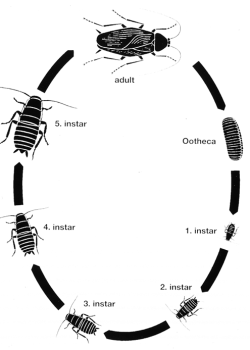They are nocturnal insects hence their presence cannot be noticed in daytime. Those seen during the day have generally been forced out by overcrowding. Cockroaches are Thigmotactic Insect (Thigmotaxis is the movement of an organism either towards or away from the stimulus of physical contact.). They usually “mass migrate”
Types:
Among 4000 species of cockroaches identified, four major species are considered as house hold pest:
- American Cockroach – Periplaneta americana
- Oriental Cockroach – Blatta orientalis
- German Cockroach – Blatella germanica
- Brown Banded Cockroach – Supella longipalpa
Habitat:
Drains, sewerage pipes, below sinks, in fridges, microwaves, cracks & crevices, underneath & inside cupboards, book shelves, furniture & appliances, around pipes or conduits, behind window or doorframes, in the bathroom, Hot-water closets, Electrical equipment, computers, wet grinders, switch boards, cardboard boxes. In other words, ALMOST EVERYWHERE.
Reproduction:
A single pair of cockroaches’ can produce seven generations consisting of 4, 00,000 individuals per annum. Female cockroaches deposit their eggs in a hardened oval capsule called an ootheca. When the eggs are almost ready to hatch, the mothers of most species either drop the egg case close to a food source or use secretions from their mouths to glue it to a suitable surface.
Life Cycle:

Harmful Effects to Humans:
- They spoil food stuff and browse over kitchen utensils in mid night.
- They spread diseases causing organisms like salmonella, fungi, bacteria, etc. Their movement invites lethal diseases to human being such as:
- Diarrhea
- Dysentery
- Cholera
- Typhoid Fever
- Food poisoning
- Allergens leading to asthma
- The faecal matter makes the living place malodorous and repulsive
Assessment of Cockroach Infestation:
- Cockroach species
- Level of infestation
- Level of sanitation
- Previous treatment History
- Harborage places
Control of Cockroaches:
- General sanitation/hygiene improvement,
- Proofing (sealing of cracks and crevices )
- To eliminate source of infestation
- Quarantine and chemical control of existing population.
PESTDOCOR Gel Treatment for Cockroaches
- PESTDOCTOR Gel Treatment is the most effective chemical control option for cockroaches.
- A new generation low dose technology molecule Fipronil 0.05 % in gel form is used as a food attractant to cockroaches.
- PESTDOCOR Gel is applied in infected areas as dots in cockroach movement areas like wall corners, cracks and crevices in kitchen, bathroom, store room, shelves and wardrobes, etc
- This odourless, harmless gel can be applied at any time of the day without causing disturbances to routine work.
- Cleaning or washing the premises is not needed after this service.
- As this gel is a food attractant for cockroaches, a single bite by one cockroach will be shared by 40 cockroaches causing a cascading effect. Hence one dot of gel can kill up to 40 cockroaches.

